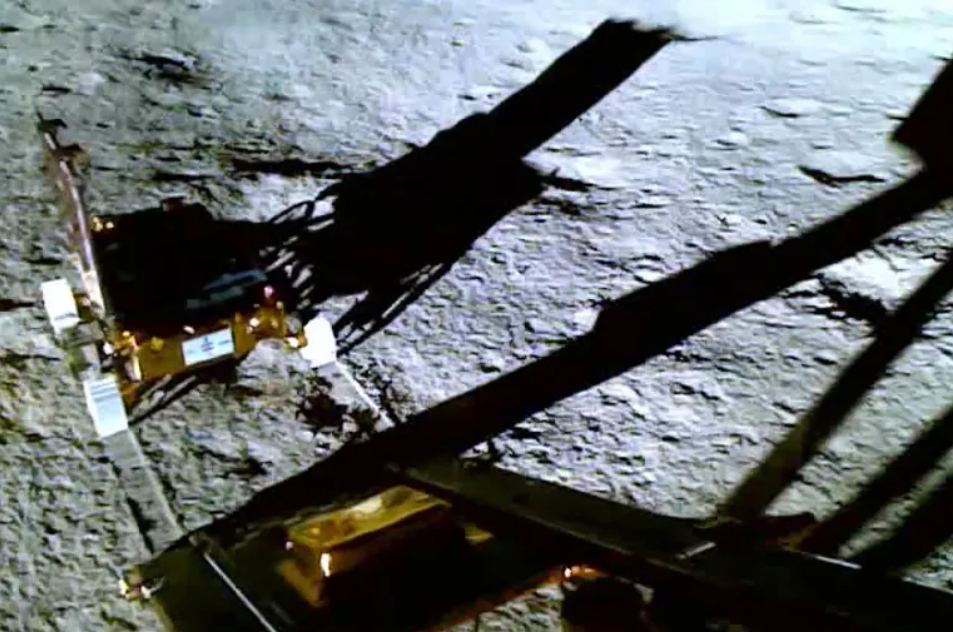India’s Chandrayaan-3 mission delivered its Vikram lander and Pragyan rover to the lunar surface on August 23rd. Now, as the lunar day ends two weeks later, the rover’s mission may be over. The Indian Space Research Organisation (ISRO) has put Pragyan into sleep mode.
We’re accustomed to rover missions that last years, thanks largely to NASA’s Mars rovers. But those rovers have MMRTGs (Multi-Mission Radioisotope Thermoelectric Generator) power plants that last for years. They’re also really expensive, whereas the Chandrayaan-3 mission cost only about $75 million.
But Pragyan relies on solar power, and lunar night is setting in. Pragyan has transmitted all of its data from its brief mission and is now hibernating. The temperature on the lunar surface will plummet to -120C (-184F), and the spacecraft’s electronics were not built to handle that.
But the battery is charged, and the receiver is still on. There’s some hope that it can be reawakened when night passes and that it can continue its mission on September 22nd. The mission’s engineering objectives were to land safely on the Moon and demonstrate the rover’s ability to drive on the Moon.
The mission met those objectives. When it comes to science, the mission’s goals were to detect water ice and to characterize the makeup of the lunar regolith. It carries a spectrometer and a spectroscope for that purpose.
Its measurements will also contribute to our understanding of lunar impacts and the lunar atmosphere’s evolution. ISRO has released some data from the mission. Temperature measurements taken by the lander showed a pronounced difference between the temperature just above and just below the surface.
The surface temperature was 50 C, and a few millimetres below the surface, it was -10 C. This is the first time the temperature has been taken near the South Pole, and it confirms what other missions have found elsewhere on the Moon. The top layer of the regolith acts as an insulator and doesn’t conduct heat very well.
The mission also detected sulphur at the South Pole. It’s been detected elsewhere on the Moon, but this is the first time it’s been detected at the South Pole. It’s also the first time it’s been detected by in-situ measurements.
The rest of the mission’s data will determine the overall outcome of the science objectives, and Indian scientists will get the first crack at the data before it’s made available to international scientists. Two days ago the Lander imager camera on #Vikram captured the #Pragyan rover doing a 360 turn. You can see it pushing up a lot of lunar regolith with its wheels.
I upscaled and interpolated the official video by @isro. https://t. co/d4XBbG9VXU pic.
twitter. com/WBUwbD4Rmi— Simeon Schmauß (@stim3on) August 31, 2023 India tried landing on the Moon in 2019 but failed, so this achievement must be extraordinarily satisfying for the people at ISRO. With this success, they’re the fourth nation to taste lunar success, after the USA, the Soviet Union, and China.
India sees itself as a great nation, and this achievement will only fuel that notion. It also likely won’t hurt that it comes shortly after Russia failed to land their Luna-25 spacecraft. India and Russia are traditional allies since the Cold War, but India is basking in success, while Russia is learning to live with failure.
India’s Pragyan rover left its mark on the lunar surface. Image Credit: ISRO This success adds to India’s growing skill in space missions. They’ve launched multiple satellites, for themselves and for other nations, and their Mangalyaan Mars Orbiter lasted 7.
5 years. They’re also about to launch their first mission to the ISS in collaboration with NASA. ISRO is also planning a joint mission to the Moon with Japan called the Lunar Polar Exploration Mission (LUPEX.
) LUPEX will feature another lander/rover mission to the Moon’s South Pole. On an interesting side note, the European Space Agency is planning on sending its Exospheric Mass Spectrometer L-band (EMS-L) instrument on the LUPEX mission. It was originally intended to go to the Moon on Russia’s Luna-25 mission, but the ESA no longer works with Russia because Russia invaded Ukraine.
There’s still a chance that Pragyan can awaken when night passes. The Sun will return on September 22nd, and ISRO hopes that the lander can continue its mission. If ISRO is successful and can awaken Pragyan, that will add to the mission’s success.
The post As Night Falls, India’s Lunar Lander/Rover Goes to Sleep. Probably Forever appeared first on Universe Today. .
From: universetoday
URL: https://www.universetoday.com/163045/as-night-falls-indias-lunar-lander-rover-goes-to-sleep-probably-forever/



